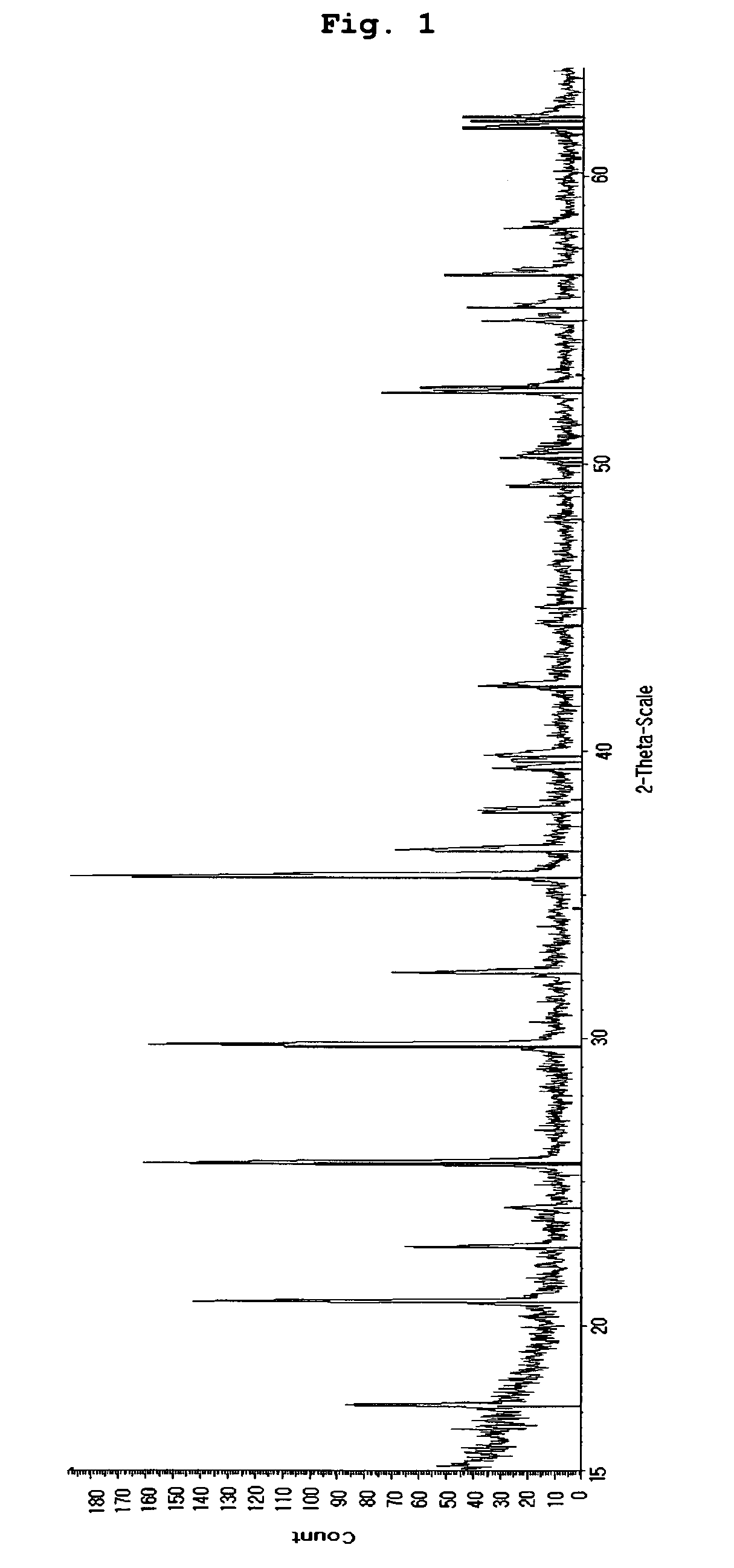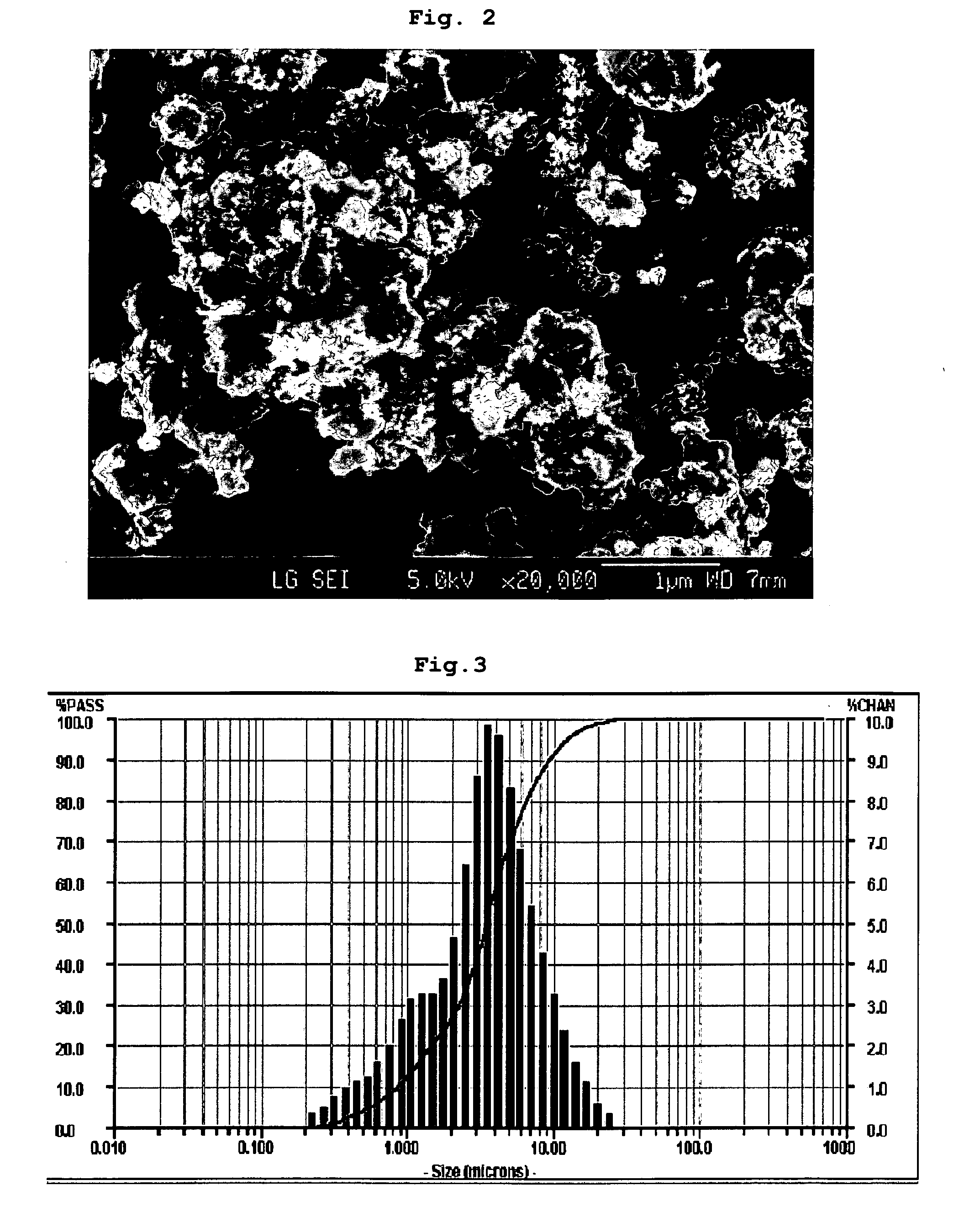Method for preparing lithium metal phosphate
a lithium metal phosphate and metal phosphate technology, applied in the field of lithium metal phosphate preparation, can solve the problems of insufficient reduction of fesup>3+/sup>, high production cost, and high cost of fesup>2+/sup> sources, and achieve excellent physical properties and excellent capacity characteristics
- Summary
- Abstract
- Description
- Claims
- Application Information
AI Technical Summary
Benefits of technology
Problems solved by technology
Method used
Image
Examples
example 1
[0059]First, 1 mole of Fe3O4 was mixed with 1 mole of Fe powder under a nitrogen atmosphere via planetary milling or ball milling. The mixture was mixed uniformly with 2 moles of Li2CO3, 4 moles of (NH4)2HPO4 and ketjen black, and the resultant mixture was fired in an electric furnace at 750° C. for 8 hours to obtain a LiFePO4 / carbon composite. The firing step was performed under a reductive atmosphere (N2+H2 2 vol %). The content of carbon in the composite was 9 wt %.
[0060]The composite obtained as described above was applied to a secondary battery according to the following method and the quality of the battery was evaluated. First, 88 parts by weight of the LiFePO4 / carbon composite was mixed with 6 parts by weight of acetylene black as a conductive agent and 6 parts by weight of PVDF as a binder, and then the resultant mixture was added to NMP (N-methyl-2-pyrrolidone) to form cathode slurry. The cathode slurry was applied onto an aluminum (Al) collector, followed by drying, to pr...
example 2
[0062]A LiMnPO4 / carbon composite was provided in the same manner as described in Example 1, except that Mn3O4 was used instead of Fe3O4, and Mn powder was used instead of Fe powder.
[0063]A coin-like half cell was provided and evaluated in the same manner as described in Example 1, except that the above LiMnPO4 / carbon composite was used as a cathode active material.
experimental example
[0068]The LiFePO4 / carbon composite obtained according to Example 1 was subjected to X-ray diffraction analysis. After the analysis, it could be seen that LiFePO4 with excellent crystallinity was formed (see FIG. 1). Additionally, the particle shape and the particle distribution were observed by way of SEM analysis and particle size analysis (see FIGS. 2 and 3). As can be seen from the photograph taken by SEM, sub-micron sized primary particles aggregate to form secondary particles having a D50 value of about 3 μm. Such a shape and size of the particles play an important role in increasing the quality of LiFePO4 particles, which, otherwise, shows a low lithium diffusion rate therein.
[0069]Since nanoparticles have a large specific surface area, they show a large area on which Li ions are diffused. As the particle size decreases, Li ions are diffused over a shorter distance to the center of the bulk of the particles, and thus the Li intercalation / deintercalation rate increases accordin...
PUM
| Property | Measurement | Unit |
|---|---|---|
| Temperature | aaaaa | aaaaa |
Abstract
Description
Claims
Application Information
 Login to View More
Login to View More - R&D
- Intellectual Property
- Life Sciences
- Materials
- Tech Scout
- Unparalleled Data Quality
- Higher Quality Content
- 60% Fewer Hallucinations
Browse by: Latest US Patents, China's latest patents, Technical Efficacy Thesaurus, Application Domain, Technology Topic, Popular Technical Reports.
© 2025 PatSnap. All rights reserved.Legal|Privacy policy|Modern Slavery Act Transparency Statement|Sitemap|About US| Contact US: help@patsnap.com



